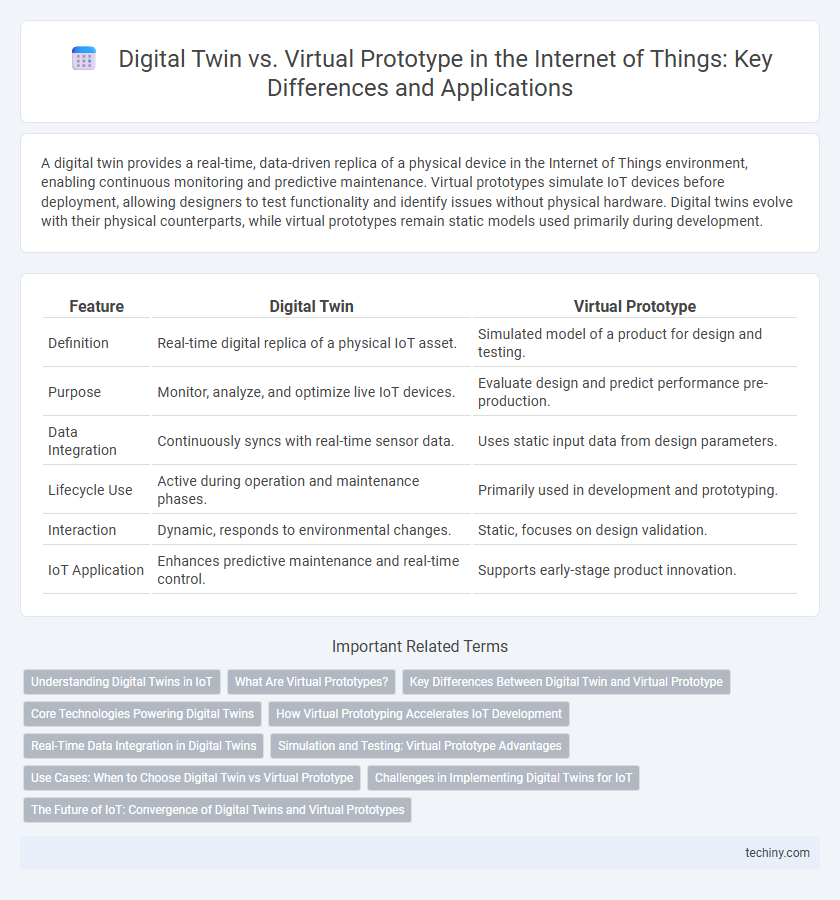A digital twin provides a real-time, data-driven replica of a physical device in the Internet of Things environment, enabling continuous monitoring and predictive maintenance. Virtual prototypes simulate IoT devices before deployment, allowing designers to test functionality and identify issues without physical hardware. Digital twins evolve with their physical counterparts, while virtual prototypes remain static models used primarily during development.
Table of Comparison
| Feature | Digital Twin | Virtual Prototype |
|---|---|---|
| Definition | Real-time digital replica of a physical IoT asset. | Simulated model of a product for design and testing. |
| Purpose | Monitor, analyze, and optimize live IoT devices. | Evaluate design and predict performance pre-production. |
| Data Integration | Continuously syncs with real-time sensor data. | Uses static input data from design parameters. |
| Lifecycle Use | Active during operation and maintenance phases. | Primarily used in development and prototyping. |
| Interaction | Dynamic, responds to environmental changes. | Static, focuses on design validation. |
| IoT Application | Enhances predictive maintenance and real-time control. | Supports early-stage product innovation. |
Understanding Digital Twins in IoT
Digital twins in IoT create real-time, dynamic replicas of physical devices, enabling continuous monitoring and predictive maintenance through live data integration. Unlike virtual prototypes, which simulate design models before production, digital twins evolve with their physical counterparts throughout the operational lifecycle. This seamless synchronization enhances decision-making, asset optimization, and system diagnostics in complex IoT environments.
What Are Virtual Prototypes?
Virtual prototypes are digital models that simulate the physical and functional characteristics of IoT devices before manufacturing, allowing for early testing and validation. They help identify design flaws, optimize performance, and reduce development costs by providing a detailed virtual representation of hardware and software interactions. Unlike digital twins, virtual prototypes focus on pre-production stages rather than real-time monitoring of deployed assets.
Key Differences Between Digital Twin and Virtual Prototype
Digital twins provide real-time synchronization with physical assets, enabling continuous monitoring and predictive maintenance, whereas virtual prototypes are static models used primarily for design testing and validation before production. Digital twins integrate live sensor data to simulate current operating conditions, while virtual prototypes rely on pre-defined parameters without ongoing data updates. The dynamic, data-driven nature of digital twins contrasts with the one-time, hypothetical scenarios tested in virtual prototypes, highlighting their distinct roles in the Internet of Things ecosystem.
Core Technologies Powering Digital Twins
Digital twins leverage core technologies such as IoT sensors, real-time data analytics, and cloud computing to create dynamic, continuously updated virtual replicas of physical assets. Unlike virtual prototypes that simulate design concepts before production, digital twins integrate live data streams for predictive maintenance and optimized operation throughout the asset lifecycle. Advanced AI algorithms and edge computing further enable digital twins to provide actionable insights by processing massive volumes of IoT-generated data in real time.
How Virtual Prototyping Accelerates IoT Development
Virtual prototyping accelerates IoT development by enabling real-time simulation and testing of connected devices, reducing physical hardware dependencies and shortening design cycles. Through digital models that mimic IoT system behavior, developers identify potential flaws and optimize performance before deployment. This approach enhances integration accuracy and minimizes time-to-market, driving efficient innovation in Internet of Things ecosystems.
Real-Time Data Integration in Digital Twins
Digital twins leverage real-time data integration to mirror physical assets accurately and dynamically, enabling continuous monitoring and predictive maintenance within IoT ecosystems. Unlike virtual prototypes, which simulate static models based on predefined parameters, digital twins process live sensor data to reflect current operational states. This real-time synchronization enhances decision-making and optimizes system performance by providing actionable insights from up-to-date information.
Simulation and Testing: Virtual Prototype Advantages
Virtual prototypes enable comprehensive simulation and testing by replicating physical products in a controlled digital environment, allowing early identification of design flaws without physical resources. They facilitate real-time performance analysis and iterative modifications, reducing development costs and time-to-market within IoT device lifecycles. Compared to digital twins, virtual prototypes offer greater flexibility for experimenting with design variations before actual production deployment.
Use Cases: When to Choose Digital Twin vs Virtual Prototype
Digital twins are ideal for real-time monitoring and predictive maintenance in IoT-enabled smart factories, providing continuous data feedback from physical assets. Virtual prototypes suit early-stage product design and simulation by enabling engineers to test and refine concepts without physical manufacturing. Choose digital twins for operational optimization and virtual prototypes for development and validation phases.
Challenges in Implementing Digital Twins for IoT
Implementing digital twins for IoT faces challenges such as data integration from heterogeneous sources, ensuring real-time synchronization between the physical asset and its virtual counterpart, and managing the scalability of complex digital twin models across large IoT networks. Unlike virtual prototypes, which focus on design validation before physical creation, digital twins require continuous data streams and advanced analytics to maintain accurate representations throughout the asset lifecycle. Security concerns and high computational demands further complicate the deployment and maintenance of digital twins in dynamic IoT environments.
The Future of IoT: Convergence of Digital Twins and Virtual Prototypes
The future of IoT hinges on the convergence of digital twins and virtual prototypes, which enhances real-time data integration and predictive analytics for smarter device management. Digital twins provide dynamic, live simulations reflecting real-world IoT environments, while virtual prototypes enable early-stage design validation and iterative testing. Combining these technologies accelerates innovation, improves system reliability, and drives optimal performance in complex IoT ecosystems.
Digital twin vs Virtual prototype Infographic

 techiny.com
techiny.com